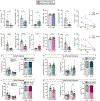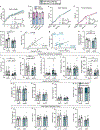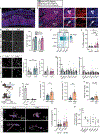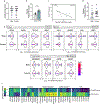Maternal diet disrupts the placenta-brain axis in a sex-specific manner
- PMID: 36443520
- PMCID: PMC10507630
- DOI: 10.1038/s42255-022-00693-8
Maternal diet disrupts the placenta-brain axis in a sex-specific manner
Abstract
High maternal weight is associated with detrimental outcomes in offspring, including increased susceptibility to neurological disorders such as anxiety, depression and communicative disorders. Despite widespread acknowledgement of sex biases in the development of these disorders, few studies have investigated potential sex-biased mechanisms underlying disorder susceptibility. Here, we show that a maternal high-fat diet causes endotoxin accumulation in fetal tissue, and subsequent perinatal inflammation contributes to sex-specific behavioural outcomes in offspring. In male offspring exposed to a maternal high-fat diet, increased macrophage Toll-like receptor 4 signalling results in excess microglial phagocytosis of serotonin (5-HT) neurons in the developing dorsal raphe nucleus, decreasing 5-HT bioavailability in the fetal and adult brains. Bulk sequencing from a large cohort of matched first-trimester human samples reveals sex-specific transcriptome-wide changes in placental and brain tissue in response to maternal triglyceride accumulation (a proxy for dietary fat content). Further, fetal brain 5-HT levels decrease as placental triglycerides increase in male mice and male human samples. These findings uncover a microglia-dependent mechanism through which maternal diet can impact offspring susceptibility for neuropsychiatric disorder development in a sex-specific manner.
© 2022. The Author(s), under exclusive licence to Springer Nature Limited.
Conflict of interest statement
The authors declare no competing interests.
Figures













Comment in
-
Mother mouse's high-fat diet changes her son's brain.Nature. 2022 Dec;612(7939):193. doi: 10.1038/d41586-022-04163-9. Nature. 2022. PMID: 36450963 No abstract available.
References
-
- Vickers MH, Breier BH, Cutfield WS, Hofman PL & Gluckman PD Fetal origins of hyperphagia, obesity, and hypertension and postnatal amplification by hypercaloric nutrition. Am J Physiol Endocrinol Metab 279, E83–7 (2000). - PubMed
-
- Kott J & Brummelte S Trick or treat? Evaluating contributing factors and sex-differences for developmental effects of maternal depression and its treatment. Horm Behav 111, 31–45 (2019). - PubMed
-
- Mina TH et al. Prenatal exposure to very severe maternal obesity is associated with adverse neuropsychiatric outcomes in children. Psychological Medicine 47, 353–362 (2017). - PubMed

